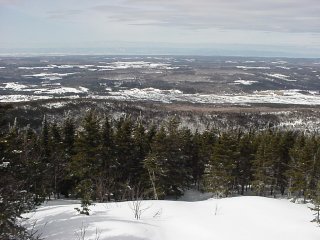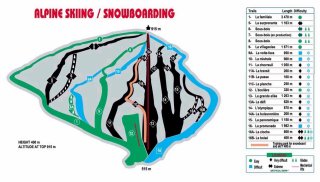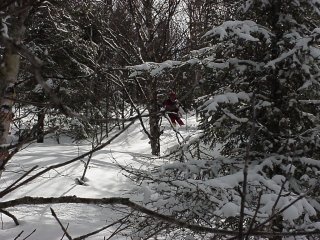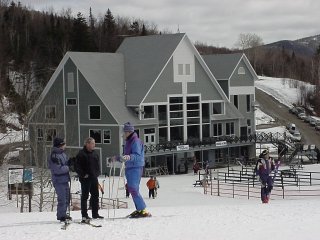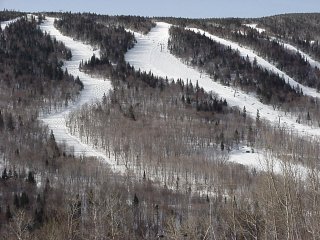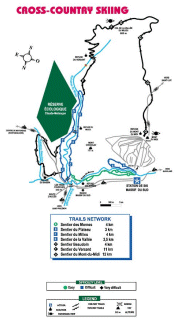St.-Philémon (QC), Canada – It was around 10:30
p.m. when I pulled into the tiny pastoral village of St.-Philémon, Québec. René
Godbout, Massif du Sud’s general manager, was convinced that I would never find
my condo in the dark, and therefore made arrangements to meet me in the parking
lot of the hamlet’s only gas station. I wasn’t quite sure of what to make of
the general manager himself venturing out late on a dark Saturday night to lead
a customer to his lodging, but no matter – I had long been intrigued by reports
of exciting, unknown skiing at Massif du Sud, and I was anxious to sample its
treasures. Arriving ahead of Monsieur Godbout, I felt obligated to explain
to the store’s owner why I was hanging out in his parking lot at 10:30 at night.
I therefore approached him at the depanneur‘s checkout counter.
“Excuse-moi, monsieur … parlez-vous anglais”
“Non.”
Uh-oh.
n
In my butchered French, I somehow managed to explain to the proprietor what
was going on, and when Godbout arrived some 10 minutes later in a minivan emblazoned
in neon graphics to create a traveling billboard for Massif du Sud, the store
owner somehow still felt obligated to come outside and point out that indeed,
this was René Godbout. It was a very friendly, albeit entirely unnecessary gesture.
|
ONLINE View La Sous-Bois,
Massif du Sud is also featured in 45th
|
The two vehicles flew over hill and dale, past where the pavement ends, and
eventually we arrived at my digs. What Godbout called a “condo,” I
call a “house.” It was a duplex with I’d guess 1,500 square feet,
two baths, and three bedrooms that slept 8, including a fireplace, a full kitchen,
and a balcony overlooking the ski area.
“But René,” I protested, “this is ridiculous! It’s only me.
All I need is a warm, dry roof.”
“Well then,” he replied with a wink and a smile, “sleep only
in one bed.”
With that, he bid me farewell until the morning. Such is the level of genuine
warmth and hospitality in this quiet agrarian corner of Canada’s French-speaking
province, tucked roughly midway between the old-world charm of Québec City and
the remote woodlands of the Maine border. The two towns closest to the ski area
both claim populations numbering less than 900.
SPRINGING BACK INTO WINTER
This was mid-April, and on this particular tour of several Québec resorts I
had encountered nearly every snow condition imaginable, from rain on refrozen
snow, to spring corn, to slush and mud patches. The only thing missing was
honest-to-goodness winter snow, but in mid-April in the East, who’s looking
to find that? I certainly wasn’t expecting to.
|
|
You may not be looking, but you very well may find it as I did at Massif du
Sud. High base and summit elevations, prodigious natural snowfall and a direct
northern exposure carried me back in time by a month. Three inches of heavy
whipping cream fell two days earlier while it rained at other resorts, and it
lay on top of a perfectly set-up base in the woods. Groomed runs were softly
edgable cruisers on packed powder that only turned wet on the very bottom of
the mountain.
This was Easter Sunday, though, and instead of hopping right on the lift,
I opted to start the day by joining Godbout in the resort’s Avalanche Bar for
a pleasant brunch. Made-to-order omelets, relaxing music, beautiful views,
and even a chef in full whites nearly completed the picture. The only things
missing from this scene were people!
Amazingly, despite its proximity to the population of Québec City one hour’s
drive to the northwest, or even Montréal 3.5 hours to the west, Massif du Sud’s
lifts only carry 38,000 skiers and snowboarders per season. This low number
is despite one of the province’s larger vertical drops and some of its heaviest
natural snowfalls of any lift-served ski area. Uphill service is presently
provided via one fixed-grip quad chair and one poma lift, but with numbers like
those, it’ll be a long time before any additional lift capacity is needed.
Only a single machine is required to keep the runs groomed. The limitation of
the resort’s operation to Fridays through Sundays, except for Christmas weeks
and the school breaks in March, further keeps the skier visits low. During the
aforementioned holiday periods, Massif du Sud stays open seven days a week.
|
Looking north from the summit toward the St. Lawrence |
These numbers used to be even lower. In 1989, the Québec government simultaneously
funded three separate ski areas in close proximity to one another – Massif du
Sud, Le Crapaudière in St.-Malachie, and La Grande-Coul Ée in the
village of St.-Paul – at the behest of starving local municipalities anxious
to jump-start their respective economies with the skier’s dollar. Additionally,
the long-established Mont-Orignal was just a few steps further down the road,
and the government’s actions thereby split the 80,000 skier visits formerly
enjoyed by Mont-Orignal amongst the four ski centers. Cannibalizing one another’s
skier traffic for years, La Grand-Coul Ée folded about three years ago,
due in part to a lack of snowmaking, and Le Crapaudière is reputed to
be hanging on by a thread. The majority of the area ski business is therefore
now split between Massif du Sud and the much smaller Mont-Orignal. Couple this
with a lack of marketing outside of Québec, and an identity crisis borne of
skier confusion between Massif du Sud and the much larger Le
Massif Petite-Rivière-St.-François just to the north, and you have the perfect
recipe for low skier density.
“People from the U.S. make no distinction between Le Massif and Massif
du Sud,” Godbout sighed. “Last November, we received a call from people
in New Jersey who wanted to make a reservation for Christmas. We received the
money, everything was paid, and two days before they came here I made a call
to see when they would arrive. I understood from that call that it was not here
that they planned to go, it was to the other Massif. I talked with them, though,
and they said ‘we will be there.’ They liked us, they liked the snow, they liked
the people. They learned some words in French, they went snowmobiling, they
went cross-country skiing, they went horseback riding … and they made a reservation
for the next Christmas. They took three condos!”
It’s in small steps like this that Massif du Sud experiences its present growth,
primarily via word of mouth. “We have to work hard,” Godbout advised.
In the few short years since its founding, Massif du Sud has had additional
difficulties of its own, including a bankruptcy in 1993. At that time, a group
of local businesspeople, convinced of the mountain’s importance to the local
economy, intervened and purchased the ski area for a paltry $800,000 in order
to continue its operation. Massif du Sud is still owned via these nine equal
shares, held by eight individuals and a group of smaller investors who together
own the ninth share. It was the current ownership group that lured Godbout
away from his ski area employment at Stoneham, north of Québec City, to assume
the leadership role at Massif du Sud.
ENOUGH CHIT-CHAT … LET’S SKI!
It was time to go exploring, and I boarded the quad chair with Alain Bernard,
Massif du Sud’s ski school director. Like Godbout, Bernard was incredibly enthusiastic
about the skiing at Massif du Sud. Skiing at an area of this size that’s so
remarkably unknown feels like you’re at your own private reserve or retreat.
Some can claim their own powder stashes, but few may claim their own entire
mountain, as we seemed to do this Easter Sunday.
|
(Click image to open a full-size trail map in a new browser
Where’s Waldo?
Massif du Sud’s modern, spacious day lodge
Wide-open cruising …
Comfortable on-mountain accomodations (Click image to open a full-size trail map in a new browser |
Massif du Sud sports an unusual topography. More of a giant plateau than an
honest-to-goodness mountain, the summit is nearly flat for several miles further
south before it descends again to lowlands and continues on to reach up toward
the Maine border. The lone chairlift rises gently at first above the lower
slopes before heading up in earnest across the steeper mid-section of the mountain,
finally ending in a long traverse across a portion of the nearly flat summit.
While at first the additional length of the chair seems relatively ineffective
in light of the additional vertical rise that it gains, the logic of the chair’s
extension makes sense when one realizes that its length allows access to the
far eastern section of the ski area without the need for an additional lift.
The skiing extends from one flank of this plateau to the other. The runs steepen
steadily as one traverses from west to east, save for one novice top-to-bottom
route that wraps around the far eastern perimeter of the area. While most runs
are named, they are commonly referred to by their numbers, which rise progressively
in sequence from east to west. While the numbering stops at 16, legitimate
separate trails have alternate numbering such as 13A, 16A, 16B, etc. The view
from the summit past tiny villages and across the lowlands to the St. Lawrence
River and Mont-Ste-Anne, on the horizon 43 miles (70 km) to the north, is stunning.
After a few steep warm-up cruises down trails #13 (La grande all Ée),
11 (La chevreuil) and 15 (La panoramique), Bernard and I headed for #5 (La surprenante),
a steep, straight bump field clearly cut with a future lift line in mind.
With a gradient approaching 65%, the turns were careful and deliberate in the
firm moguls, yet to be softened by the April sun. With legs like jell-o at
the end, suddenly the mountain’s 1,312 vertical feet (400 m) didn’t seem so
small after all.
There was no rest for the weary, however, as we cranked things up another notch
and dove into the steep #6, a sous-bois (which translates from French
literally as “under the woods,” meaning a glade) built in the tight eastern
tradition on the same 65% grade that is home to #5. Rather than the latter’s
firm bumps, however, here we found a mix of a Styrofoam base resurfaced by a
couple of inches of thick, creamy topping, and small moguls. A true delight.
There are lots of local stashes, too, some easier to find than others. One
I legitimately stumbled onto on my own (i.e., stop in the woods, look uphill,
and “Oh my God, look at that!!”), and others were glades that
the ski area had started to clear but not yet finished or opened. One in particular,
named “La rivière,” is predictably a narrow streambed with
incredibly steep walls. Other sous-bois runs are marked and signed,
but do not appear on the trail map, including #4 and #7.
The natural woods themselves are wonderfully skiable in many locations on the
mountain – and surprisingly unskied. “I’ve never been this far out here,”
Bernard exclaimed as I kept leading him further and further out of bounds to
find what were arguably the best “goods” of the day. The trail numbering here
only goes as high as 16, and when we stopped back in Godbout’s office and he
asked where we’d been, Bernard matter-of-factly replied, “We’ve been skiing
number 17 and number 18.” The look that Godbout shot sideways at him was
priceless.
Aside from trail #1 (La familiale), the aforementioned novice route from the
summit which descends the eastern edge of the resort, Massif du Sud’s terrain
is nearly entirely of an intermediate level or better, a weakness that the mountain’s
management understands and seems content to live with. As skier demand dictates,
gentler terrain may be added in the future beyond the resort’s present western
boundary. The ski area’s permit area and holdings extend far beyond that which
is currently accessed via lift.
I think that it’s the first time all season that I was actually sorry to see
4:00 arrive, and wished that I had time to ski more.
NO
ROOM AT THE INN
Lodging at the ski area is an incredible bargain, seemingly too good to be
true. Ski and stay on-mountain condo packages were priced for the 2000-2001
winter season at $59.95 CDN ($39.05 USD at press time) per person per night,
based on quad occupancy and a two-night stay. The rate drops to $41.95 CDN ($27.32
USD) per person for 8 people per unit. Think about it … that’s less than $55
for two nights in a condo and two days of skiing!
While Massif du Sud would in the future like to bring in an independent operator
to build and manage a small inn, the on-mountain lodging is presently extremely
limited. Nothing is available slopeside. Except for 100 pillows near the ski
area base in the form of independently-owned condos and chalets, and a mere
handful of small bed-and-breakfasts scattered about the local villages, the
nearest lodging is some 30-35 miles away in Montmagny, or an hour away in Québec
City. Choosing the latter as a base provides you with a central location from
which to access not only Massif du Sud, but also Le Massif Petite-Rivière-St.-François,
Mont-Ste.-Anne, Stoneham and Le Relais, plus the ultimate après-ski scene
and location for the non-skier.
Lift tickets are incredibly inexpensive as well, with a 2000-2001 adult day
ticket topping out at $21.69 CDN plus tax ($14.13 USD). A nordic trail network
pass will set you back $6.09 CDN plus tax ($3.97 USD), or $8.90 CDN ($5.80 USD)
if you’d like to start off with a chairlift ride to the summit plateau.
NORDIC PARADISE
Massif du Sud has a huge 56-km nordic network, much of which begins at the
summit. The nordic skier may ride the chairlift to access this terrain, including
a 14-km run across the plateau and down into a drainage that returns to the
ski area. The backcountry possibilities in that drainage seem encouraging. Here
in mid-April, trailside nordic trail signposts, which I’m told are eight feet
in height, barely poked through the snowpack. From the southern summit several
miles south of the ski area, one could see Saddleback, Bigelow and Katahdin
on the horizon, all in Maine.
Looking for another way to access these stunning views? Stop by the Ranch
Massif du Sud, located just down the access road from the ski area, and
hop into the saddle for a horseback ride to the summit. Other alternative activities
available in the region include snowmobile and dog sled excursions.
If you’re looking for snow, solitude and genuine local warmth, you’ll find
Massif du Sud hard to beat.


